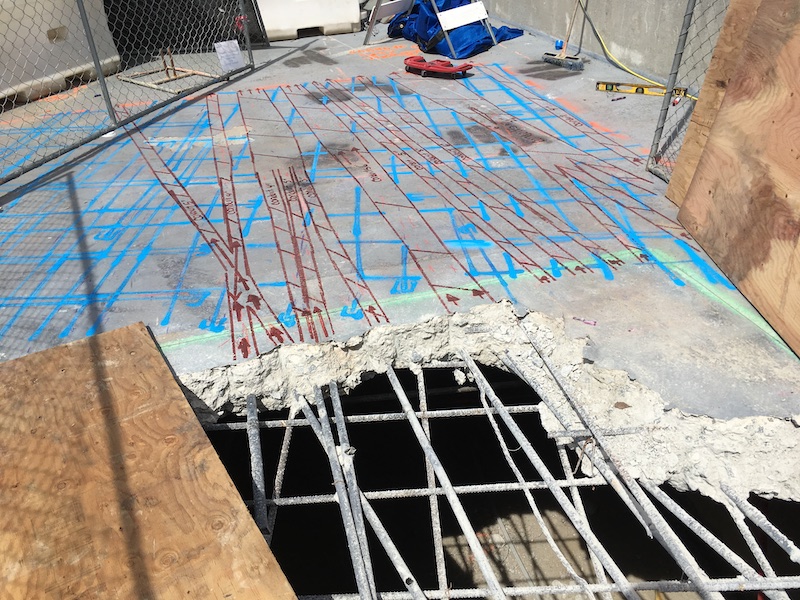Accuracy and Precision in Concrete Scanning Solutions
Elevate Your Construction Refine With the Strategic Insights of Concrete Scanning for Enhanced Performance
One such technology that has changed the building and construction sector is concrete scanning. By using the tactical insights provided by concrete scanning, construction specialists can open a realm of boosted performance and streamlined procedures.

Advantages of Concrete Scanning
Enhancing project efficiency and safety and security, concrete scanning offers a non-destructive method for finding surprise objects within concrete frameworks. By utilizing modern technologies such as ground-penetrating radar (GPR) and concrete x-ray imaging, construction teams can accurately find rebar, post-tension wires, electric channels, and other obstructions before exploration, cutting, or coring into concrete.
The advantages of concrete scanning are numerous. It minimizes the risk of unintentional damage to crucial structural components, lowering the probability of pricey fixings and project delays. It boosts employee security by supplying real-time understandings into the area of covert risks - Concrete Scanning. Construction websites can be intricate atmospheres, and knowing what lies below the surface area can protect against injuries and accidents.
Additionally, concrete scanning promotes overall project performance by streamlining operations and stopping rework. By determining possible issues at an early stage, groups can change their plans proactively, saving time and resources in the future. Fundamentally, the adoption of concrete scanning modern technologies is a critical financial investment that pays rewards in terms of security, cost-effectiveness, and performance.
Technology Assimilation for Effectiveness
Concrete scanning's capability to streamline operations and boost job efficiency can be more enhanced through critical integration of cutting-edge technologies. By incorporating Structure Info Modeling (BIM) software application into concrete scanning procedures, building teams can attain a higher degree of accuracy and coordination. BIM permits the production of 3D versions that provide detailed insights into the job, enabling better decision-making and lowering the likelihood of errors. In addition, the combination of Enhanced Fact (AR) technology with concrete scanning can improve on-site visualization, enabling job managers and workers to overlay digital info onto the physical atmosphere in actual time. This can promote a lot more exact positioning of aspects and enhance interaction amongst group members. The use of drones for airborne studies in combination with concrete scanning can speed up data collection and analysis, making it possible for much faster decision-making and progress tracking. In general, the tactical combination of these innovations can substantially improve performance and productivity in building tasks.
Avoiding Pricey Mistakes
Exactly how can meticulous interest to information during concrete scanning processes aid building teams in avoiding costly errors? Concrete scanning plays a vital role in identifying prospective concerns prior to they rise into costly errors. By making use of advanced scanning innovations such as Ground Permeating Radar (GPR) and electromagnetic induction, building teams can properly spot rebar, utilities, spaces, and various other blockages within concrete structures. This degree of accuracy allows task managers to make informed decisions concerning the design and layout of their construction strategies, minimizing the risk of accidental damage to crucial facilities during the building procedure. Furthermore, concrete scanning assists in guaranteeing structural honesty by determining weaknesses or problems in the concrete beforehand, permitting for prompt repair work and adjustments. By proactively addressing these issues, construction groups can stay clear of pricey errors such as rework, hold-ups, or security hazards that may emerge from ignored disparities in the concrete structure. Ultimately, purchasing comprehensive concrete scanning procedures shows to be a cost-effective strategy in the future, conserving both time and sources while enhancing overall project performance and top quality.
Enhancing Job Monitoring
Meticulous focus to information throughout concrete scanning processes not only helps in preventing pricey mistakes but also lays a strong structure for reliable job monitoring in building and construction endeavors. By integrating concrete scanning technology right into job monitoring approaches, building and construction groups can simplify operations, boost interaction, and ensure that projects remain on track.
Concrete scanning offers important insights into the structural honesty of existing aspects, permitting job supervisors to make informed choices relating to style alterations or building and construction sequences. This proactive strategy reduces the threat of unanticipated hold-ups or remodel, ultimately conserving time and sources. In addition, the information gotten from concrete scanning can be integrated into Structure Info Modeling (BIM) platforms, making it possible for real-time collaboration and sychronisation amongst numerous stakeholders.
In addition, concrete scanning aids job supervisors identify potential dangers or challenges prior to they rise right into bigger problems, promoting a more secure workplace for all entailed. With improved visibility and accuracy provided by concrete scanning modern technology, find more information job managers can effectively plan, check, and perform building and construction jobs with better efficiency and confidence.
Making Best Use Of Productivity
To boost productivity in construction tasks, carrying out effective techniques and using innovative technologies is vital. Maximizing performance includes improving processes, maximizing resource allowance, and decreasing downtime. One essential element of making best use of efficiency is through the fostering of concrete scanning modern technology. By utilizing ground-penetrating radar (GPR) and other scanning methods, building and construction groups can properly locate rebar, conduits, and various other subsurface components, decreasing the threat of pricey mistakes and hold-ups during excavation and boring.
Moreover, embracing Structure Details Modeling (BIM) software can substantially boost efficiency by producing in-depth 3D versions that boost task visualization and coordination among various trades. BIM enables much better clash discovery, allowing problems to be recognized and solved before building also starts, conserving time and resources in the future.
Executing a lean construction approach, which concentrates on removing waste and maximizing effectiveness across all task stages, is one more efficient technique for optimizing efficiency. By fostering cooperation, interaction, and continual renovation, building groups can function more cohesively towards achieving task goals in a structured and efficient manner.
Verdict
In final thought, the tactical application of concrete scanning in the building and visit their website construction procedure offers various advantages, consisting of raised efficiency, cost savings, boosted task administration, and improved productivity. By incorporating this innovation, construction groups can prevent costly mistakes, improve their operations, and optimize their general project result. Concrete scanning is a beneficial tool that can elevate the construction process and result in more successful and successful results.
